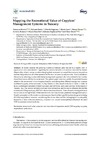Please use this identifier to cite or link to this item:
https://accedacris.ulpgc.es/jspui/handle/10553/75253
| Title: | Mapping the recreational value of coppices’ management systems in Tuscany | Authors: | Riccioli, Francesco Fratini, Roberto Fagarazzi, Claudio Cozzi, Mario Viccaro, Mauro Romano, Severino Rocchini, Duccio Diaz, Salomon Espinosa Tattoni, Clara |
UNESCO Clasification: | 590208 Política del medio ambiente 531102 Gestión financiera 2599 Otras especialidades de la tierra, espacio o entorno |
Keywords: | CES Mapping Ecosystem Services Interval Regression Model Mapping Respondents’ Preferences Recreational Value |
Issue Date: | 2020 | Journal: | Sustainability (Switzerland) | Abstract: | In recent decades the growing interest in forested areas has led to a higher level of appreciation and consideration regarding the various benefits and services provided by forests. Despite this, when it comes to acknowledging their economic value and their capacity to produce income, the production of timber seems to be the main or even the only function that is considered. However, by adopting a sustainable forest management approach, the value related to non-market forest functions could also be considered. The present paper aims to quantify the potential income related to the recreational value of coppice forest by considering three different management systems: traditional coppice, active conversion to high forest and the natural evolution of forest. In order to do so, a contingent valuation method was used, and 248 forest users were surveyed in the region of Tuscany, Italy. The surveys included a revised price-list method, and the results obtained showed the existence of willingness to pay (WTP) for the maintenance of forests. Users showed a strong preference for conversion to high forest, while natural evolution was the least preferred management option. People’s perception on this matter was also assessed based on their specific location, by georeferencing all of the respondents’ answers: considering this, it was observed that belonging to a municipality located in or close to the mountains (i.e., mountain and natural municipalities) influenced the users’ WTP to maintain natural evolution. | URI: | https://accedacris.ulpgc.es/handle/10553/75253 | DOI: | 10.3390/su12198039 | Source: | Sustainability (Switzerland) [EISSN 2071-1050], v. 12 (19), p. 1-18, (Octubre 2020) |
| Appears in Collections: | Artículos |
SCOPUSTM
Citations
7
checked on Jun 8, 2025
WEB OF SCIENCETM
Citations
6
checked on Jun 8, 2025
Page view(s)
118
checked on May 31, 2025
Download(s)
103
checked on May 31, 2025
Google ScholarTM
Check
Altmetric
Share
Export metadata
Items in accedaCRIS are protected by copyright, with all rights reserved, unless otherwise indicated.
